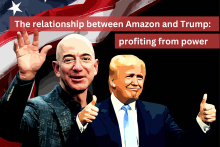Technology’s Carbon Footprint
Many tech companies have a staggering environmental impact. In 2018 alone, Amazon calculated a carbon footprint of 44.4 million tonnes of CO2e for its direct and a very limited selection of its indirect operations.
To put that in context, that’s equivalent to about 55.5million return passenger flights from London to New York, without even covering emissions from its supply chain.
While Microsoft’s yearly carbon footprint is less than Amazon’s, expected to emit 16 million tonnes in 2020 across its direct and indirect operations, this still equates to 20 million return flights to New York.
With huge environmental footprints, it is difficult to envision how these global companies can reach carbon neutrality. Yet, according to climate pledges made in 2019 and 2020, the two tech giants claim this is their goal.
Amazon’s Pledge
A letter to Jeff Bezos and Amazon’s Board of Directors in April 2019, signed by 8702 workers, asked for concrete climate action that addresses the company’s carbon emissions, and questioned Amazon’s investment in fossil fuels.
At the time, Jeff Bezos, the Amazon founder and CEO, failed to provide a meaningful response to the environmental concerns of Amazon employees.
Yet, in September 2019, Bezos announced a corporate “climate pledge” in which Amazon was the first participant.
This pledge commits the firm to sourcing 100% of its energy from renewable sources by 2030 and aims to achieve net zero carbon emissions by 2040. Of course, a huge multinational corporation like Amazon committing to carbon neutrality would be incredibly significant in efforts to decarbonise the economy. Unfortunately, it seems that the pledge may be misleading.
Greenpeace’s analysis concluded that the pledge lacks detail regarding how Amazon will reduce its footprint to zero and includes no elaboration on how the company will procure 100% renewable energy by 2030.
More significantly, the plans only concern Amazon’s own operations, excluding the carbon footprint of their global supply chain, which accounts for 75% of its carbon footprint.
Even if we took Amazon at their word regarding renewables and their net zero target, upcoming plans and recent action are arguably in contradiction with the principles of Bezos’s climate pledge. Currently, Amazon offer the use of AI technologies to oil companies including BP and Shell.
Moreover, Amazon employees have been reported to have been fired for speaking publicly about the company’s environmental record. The company has justified its actions citing a recently updated external communications policy, which prohibits employees from speaking out about its internal business. Although ambitious targets are needed, it’s actions like these that call into question the legitimacy of Amazon’s pledge.
Microsoft’s Pledge
With a more ambitious target, Microsoft aims to source 100% renewable energy by 2025.
Even further, the company aims to become carbon negative by 2030, pledging $1 billion to negative emissions technologies. The company says that it will achieve these targets through “power purchase agreements for green energy” for all of Microsoft data centres, buildings and campuses as well as obtaining fully electrified vehicles by 2030.9
Microsoft’s aims have been generally praised and Microsoft’s pledge is more promising in terms of acknowledging the emissions of its entire supply chain.
Nonetheless, the company has plans to continue partnerships with oil companies. Only recently did Microsoft partner with ExxonMobil, a company which has pledged to expand their production to 50,000 oil-equivalent barrels a day by 2025. Similar to Amazon, offering beneficial AI technologies to oil companies contradicts aims to achieve carbon neutrality.
What to look out for
Companies must set ambitious targets if we’re to meet the 1.5 degree Paris target globally. Yet, corporate climate pledges can fail to acknowledge the full scope of a company’s direct and indirect emissions.
When judging if a green pledge is greenwash, it’s useful to look out for a few things:
How ambitious are the company’s goals? Do they align with the Paris Agreement targets?
How specific is their time-frame?
Do pledges account for Scope 1, 2, and 3 emissions?
The Carbon Trust defines Scope 1 and 2 emissions as those produced directly, including emissions from vehicles and electricity purchases.
Scope 3 emissions are indirect, from areas such as purchased goods and services or those within the supply chain, investments and business travel. Scope 3 emissions are often not accounted for - or only very basic ones like business travel are included. This is the case with Amazon, one of the many reasons why Microsoft’s pledge is far more robust.
It’s also worth checking whether a company’s other actions - that wouldn’t technically be accounted for in their carbon footprint - contradict their stated aims, as with both Amazon and Microsoft openly pursuing partnerships with oil companies.




